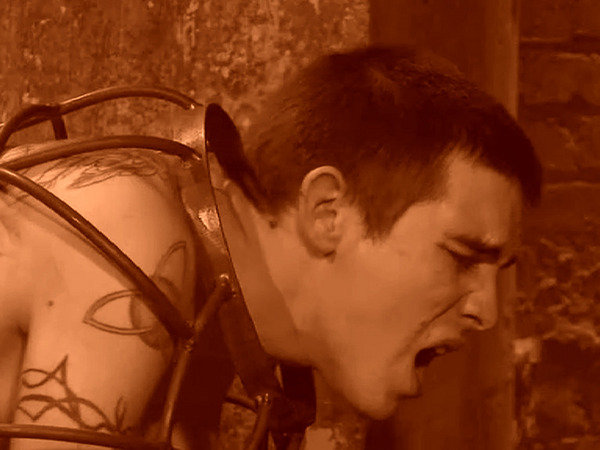Two exhibitions
dal 18/9/2014 al 29/11/2014
Segnalato da
18/9/2014
Two exhibitions
De Hallen Haarlem, Haarlem
Michel Auder's exhibition presents a new large overview of an influential older artist who has for a long time remained under the radar of a large audience. Christian Friedrich produces sculpture, staged video work and monologues, which are usually part of an architectural intervention in the exhibition space.

This autumn De Hallen Haarlem is realizing two notable solo
exhibitions by renowned filmmaker Michel Auder and versatile
artist Christian Friedrich. Both artists are known for stretching
the boundaries of the medium of video and film to the limit.
Auder is a tireless chronicler, who since the 60s has been
capturing events in his direct environment and in the lives of
his artist friends on camera, be it Super 8 or iPhone. Originally
influenced by the French Nouvelle Vague, he developed his
own genre that ping-pongs between diary-like home video and
experimental film. Friedrich, whose work includes both
conceptual sculpture as well as audio works and installations,
develops exceptional editing techniques and a completely
original film language in which elements of stylized music
videos, DIY porn and granular performance recordings are
combined.
---
Michel Auder
After the Charles Atlas exhibition in De Hallen Haarlem in
2012, Michel Auder’s (1945, FR / USA) exhibition presents a
new large overview of an influential older artist who has for a
long time remained under the radar of a large audience. The
scene surrounding Andy Warhol’s Factory with whom he came
in contact through his wife Viva, one of Warhol’s favourite
Superstars, defined Auder’s early New York career. After that
he devoted himself to travel accounts, portraits of artists, TV-
collages and experimental feature films. In all of these he
shows a remarkable sense for the small details in everyday
life; his films elevate the mundane to the extraordinary.
The exhibition in De Hallen Haarlem concentrates on different
periods in Auder’s career, from early experimental films such
as Keeping Busy (1969) and Cleopatra (1970) to
recent work
made with an iPhone. The downstairs area of the Vleeshal will
be devoted to video works; the top floor of the Vleeshal will
offer visitors a cinematic experience. This exhibition follows
last year’s presentations of Auder’s work at the Kunsthalle
Basel, Culturgest in Lisbon and Portikus Frankfurt, which
brought a renewed interest in his work. De Hallen Haarlem recently acquired five of Auder’s film works: Chronicles
(Morocco) (1971-72), Polaroid Cocaine (1993), Endless
Column (2011), Untitled (I Was Looking Back To See If You
Were Looking Back At Me To See Me Looking Back At You)
(2012) and The Town (1999).
---
Christian Friedrich
With Christian Friedrich’s (1977, DE) first solo exhibition, De
Hallen Haarlem offers the stage to a high-profile young talent.
Friedrich studied theology and philology before going to art
school and is difficult to pin down to one specific artistic
method. He produces sculpture, staged video work and
monologues, which are usually part of an architectural
intervention in the exhibition space. A striking aspect of
Friedrich's practice is the big contrast between individual
works: in the series Types, for example, he refers explicitly to
the sleek sculptures of the Minimalists, while a video
installation such as The Stone That The Builder Rejected
evokes a baroque world that is pushing the limits of kitsch.
A common thread in Friedrich's art is the subjugation of the
human body. He regularly presents the body as an object of
desire; at the same time it is the use of sadomasochist
symbolic power games that can lead to a sublime experience.
For the video work The Stone That The Builder Rejected, for
example, the artist had to submit to the will of an unknown
person. He invited a boy from a personal advertisement in his
studio, where this boy encountered a theatrical setting with the
artist himself in the centre. The innocent, angelic visitor was
subsequently free to respond to this absurd encounter. In this
work Friedrich is employing a perverse game of power
relations (between artist and muse, between artist and
audience, between people in general). This unrehearsed
meeting between two strangers is a good example of how the
artist is trying, within a predetermined framework, to leave as
much as possible to chance.
In another work, created especially for the exhibition, Friedrich
developed an algorithm to 'edit' information on the basis of the
stuttering pattern of a severe stutterer. The work has an
unethical tinge to it, while at the same producing unexpected
beauty.
The Friedrich exhibition is a co-production of De Hallen
Haarlem and Grazer Kunstverein. The artist was able to make
new work for this project by the kind support of the Mondriaan
Foundation.
De Hallen Haarlem is a beneficiary of the BankGiro Lottery.
Image: Christian Friedrich, Untitled, 2010-2011. DV and found footage transferred into digital, file, silent. Courtesy the artist and Wilfried Lentz Rotterdam. With the support of C.o.C.A.
Press information
Annelieke van Halen
a.vanhalen@dehallen.nl
+31 (0)23 5115794
Opening: Friday 19 September, 5 p.m.
De Hallen Haarlem
Grote Markt 16, Haarlem
Opening Hours
Tuesday-Saturday 11:00 - 17:00
Sundays and bank holidays 12:00 - 17:00. King's Day 12:00 - 17:00
Easter Monday and Whit Monday the museum will be open from 12:00 - 17:00
Closed on Christmas Day and New Year’s Day
Admission Prices
Adults € 7.50
Groups (per person) € 6.00
19 - 24 / Studentcard € 4.00
Children 18 and under free
Museum card free
ICOM free
Friends of De Hallen Haarlem free
Rembrandt Society free



